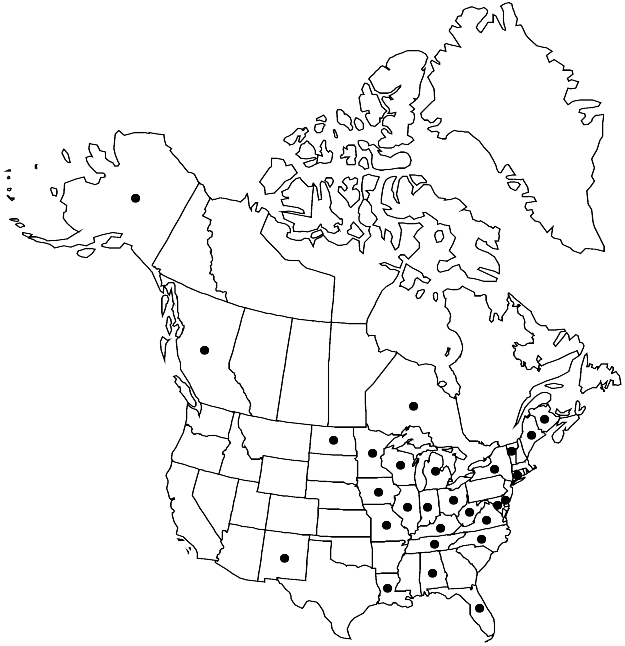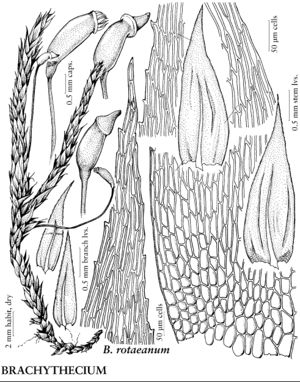Brachythecium rotaeanum
Comment. Soc. Crittog. Ital. 2: 285. 1867.
Plants medium-sized to moderately large, in loose to moderately dense mats, light green with somewhat bluish tinge, fading to yellowish green, then brownish stramineous. Stems to 7 cm, creeping but ascending from substrate, terete-foliate, irregularly branched, branches to 6 mm, straight to slightly curved, terete-foliate. Stem-leaves erect to erect-appressed, imbricate, ovatelanceolate, broadest at 1/10 leaf length, concave, not strongly plicate, plication variable in same plant, (1.7–) 2–2.8 × 0.6–0.9 mm; base slightly narrowed, narrowly short-decurrent; margins plane or occasionally recurved at places, especially in transition to acumen and in leaf corners, almost entire to strongly serrate, dentition variable on same plant; apex gradually tapered or acuminate; costa to 60–75% leaf length, slender, terminal spine present or absent; alar cells subquadrate to short-rectangular, same size or smaller than basal-cells, 12–20 × 10–12 µm, walls moderately thick, region indistinctly delimited, in several submarginal rows; laminal cells linear, 45–90 (–120) × 6–10 µm; basal-cells to 12–16 (–19) µm wide, region in 5–8 rows, pellucid, markedly different from more distal cells. Branch leaves with margins usually strongly serrate. Sexual condition autoicous. Seta dark cherry red when young, redbrown with age, (1–) 2.3 cm, smooth. Capsule occasionally inclined to horizontal and curved, cherry brown to very dark-brown, elongate to subcylindric, straight proximally, somewhat curved distally, 1.8–2.3 mm; annulus separating by fragments; operculum long-conic, sometimes broadly short-rostrate. Spores 16–20 µm.
Habitat: Trees, bases and inclined trunks, fresh logs, soil, rock
Elevation: low to high elevations (0-2900 m)
Distribution

B.C., N.B., Ont., Ala., Alaska, Conn., Del., Fla., Ill., Ind., Iowa, Ky., La., Maine, Md., Mich., Minn., Mo., N.Mex., N.Y., N.C., N.Dak., Ohio, Tenn., Vt., Va., W.Va., Wis., Eurasia
Discussion
Brachythecium rotaeanum belongs to the B. salebrosum complex; many collections have been identified in herbaria as B. salebrosum. H. Robinson (1962) separated this species from B. salebrosum mainly by the homogeneous basal cells, somewhat similar to those of B. laetum. This is closer to the circumscription accepted here, although the basal cells of B. rotaeanum, which are rather large, should probably not be considered very similar to those of B. laetum, which are small and opaque. When growing protected from direct light, B. rotaeanum has a green and slightly glaucous color, often useful for recognition of it in the field. This color is more similar to that of B. laetum than of B. salebrosum (dirty yellowish) or B. campestre (stramineous to somewhat whitish). In the southern states, there is also a problem with the separation of small plants of B. rotaeanum from depressed phenotypes of B. ruderale with only branch leaves that are ovate-lanceolate with homogeneous cells across the leaf base. However, even in such phenotypes of B. ruderale, it is possible to find stem leaves that are abruptly long-acuminate; in addition, the latter species is dioicous, while B. rotaeanum is autoicous.
Selected References
None.
Lower Taxa
"long" is not a number."broad" is not a number.
